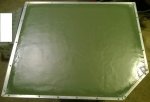Being impatient, I cut out a piece of plywood in the proper dimensions, and made it a door.
The entire plywood is encased in fiberglass mat and resin, and the edges are angle-aluminum to provide rigidity and protection from warping or damage.
The wet-looking edges are sprayed with "Flex-seal" (As seen on TV!

) to prevent insect move-in or water intrusion and ice damage.
If I could do it over, I'd have used the aluminum channel for the edges, and put it on before the fiberglass work, then just sand it off the aluminum. I'll do that when/if I replace the factory door on the other side.
I sanded the surface after the first layer, and was really going for the boat-hull smooth look, but eventually said screw it, I just need a quiet door, not a body-working masterpiece.
What I didn't get pics of yet are the hinges (nothing special at all, just surface mounted zinc hinges), and paint, but I expect to paint the entire unit eventually, so I can wait until then for pics. I also haven't settled on a latch. I'm too cheap to get similar recessed latches to factory, but the Lowes Chest-latches are too flimsy.


The door being plywood is dual purpose. It's conducts sound less than the thin factory aluminum sheet, and it's a sturdy section of interior protection.
This is intended to be my permanent household backup power, so I gave this machine extra acoustical treatment... The top sheetmetal has mass-loaded vinyl lining the underside, then acoustic foam on that. The ramp above the fan has mass-loaded vinyl on the interior side. The base/floor of the interior has expanding-foam (Great-Stuff) sections that both hold the batteries in place, and insulate the floor from higher frequency noise (though it looks terrible and like a bad finish, the bubbly surface is intentional for interrupting sound waves). The interior sections (AC contactor area, and control box area) have both expanding foam and acoustic foam sections lining them. The remaining factory engine door will have a heavy foam mat attached to the interior (ready to go, just have to get around to removing the data plates).
I also replaced the door gaskets with new weatherseal material that should fill gaps and prevent sound leakage.
I still have to treat the end doors below the control box, but they don't seem to be conducting much sound; there's an audible difference between open and closed on those doors, so acoustic material on them should help even more.
Perfect quiet is not possible without a permanent install that has some control of the exhaust and cooling air flow, but so far this has made a huge difference. When I got this machine, it was half as loud as a mep-00xa, but still louder than some portable civilian gensets I've run that were acoustically treated (I rented a 25kw from Hertz once that you could barely hear running with the doors closed). Today, I would have no problem running this thing through the night in our sleepy little town. I currently feel like the biggest a-hole on my street when I let my Mep-002a run through the night...but when ya need heat, ya need heat...




